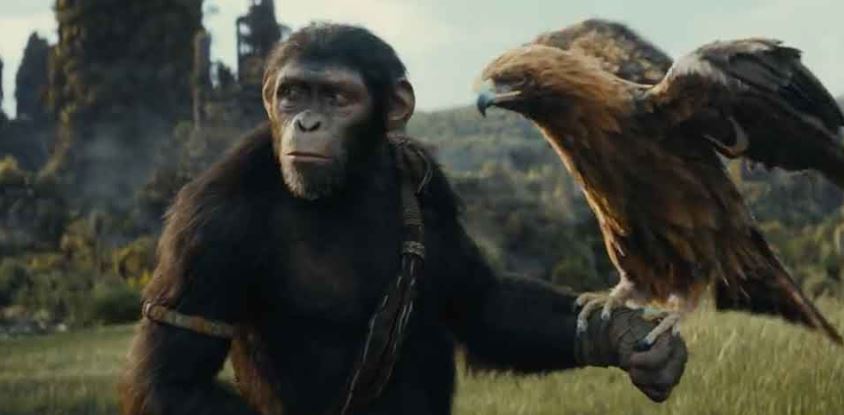There ought to be a sort of Turing test for digital animation. If you don’t know you’re looking at a digital creation, the test is passed. Kingdom of the Planet of the Apes would pass such a test with flying colours, even though you couldn’t possibly forget you are looking at digital apes for one simple reason: real apes don’t talk. These apes, multi-dimensional both in personality and in the space they occupy, would certainly convince you otherwise. It’s what the Planet of the Apes reboots have been doing since Rise of the Planet of the Apes in 2011, only with nearly 15 years’ more technological sophistication than that first.
Unfortunately, these apes are so good, and such good characters, that it’s the humans opening their mouths that kind of ruin things. Unlike its predecessors, which take place in the distant past in this timeline, Kingdom gets by without any human characters at all for a good 45 minutes. Emphasis on “good.” That sheer quantity of time indicates just how little these digital creations need us, either from a visual or a story perspective. But because human beings are always going to be a viewers’ greatest source of personal identification, they do have to eventually appear, sometimes quite awkwardly. (It may never have been possible for William H. Macy to be anything but a distraction.) Fortunately, humans are more a necessary evil than the centre of this story, and the centre is quite good.
It’s “many generations” after the passing of Caesar, the ape voiced and motion-captured by Andy Serkis in the trilogy that concluded with 2017’s War for the Planet of the Apes. Yet Caesar’s teachings are still alive in his descendants, having assumed more of a status as legend at this point. Some apes, like young Noa (voice of Owen Teague) and his mates who are about to come of age, innately embody Caesar’s philosophies about kindness and mercy, even if they have no awareness of Patient Zero of the ape uprising. Others, like vicious warlord Proximus Caesar (Kevin Durand) and his lieutenant Sylva (Eka Darville), know enough of the Caesar legend to evoke his name after victory in battle, but not enough to recognise the way they are bastardising it.
Humans in this world are a primitive afterthought in the territorial conflicts between apes, such as Noa’s peaceful village that just wants to keep to itself, and Proximus Caesar’s group bent on enslaving and destroying. It’s commonly thought that humans, intellectually dulled and muted by the original virus, are just scavengers, with few apes knowing they were once the dominant species on the planet. But one such scavenger, Mae (Freya Allan), begins following Noa and his new friend Raka (Peter Macon) after Proximus has raged through Noa’s village, leaving the two apes to seek out the enslaved survivors of the onslaught. It turns out she might defy the stereotype of humans in more ways than one, and present more dangers than they expect in terms of the future balance of power on this planet.
It’s hard to overstate just how fully you rest in the capable hands of director Wes Ball and writers Josh Friedman, Rick Jaffa and Amanda Silver at the start of this movie. We open on a quest by Noa and his two closest friends to steal eagle eggs from nests perched high in the sky, which gives a great showcase for this former human world overgrown with centuries of new foliage. And just when we think these apes are cruelly depriving the eagles of their young to feed themselves, we learn that this is a ritual for young apes becoming adults, to care for an egg and raise the offspring with as much care as would be supplied by its own mother. It’s kind of like how primary school kids in our world have to take an egg home and carry it around all weekend without cracking it.
This section of the film, and many parts of what follows, are good enough not to get stalled out on the inevitable disappointments in the second and third acts. It might have been a bold masterstroke to restrict this film simply to interactions between apes, something along the lines of what Mel Gibson did when he filmed the dynamite action film Apocalypto entirely in an ancient Mayan dialect, challenging cinephiles to do some work and reap the rich rewards thereof. Perhaps Kingdom of the Planet of the Apes could never have eschewed human beings entirely, since we can’t forget we are working our way up to a previously documented time period that did feature humans: the 1968 original with Charlton Heston. Still, the apes are infinitely more worthy of our attentions and our affections, and what’s revealed about the humans in the third act is only worthy of our groans.
But we said we would not get stalled out. And in truth, Kingdom of the Planet of the Apes is a big step forward for its creatives. Director Ball made his name directing three Maze Runner movies. Those were not bad movies and they did show some capacity for working on an epic scale, but they could never fully overcome their YA origins. What Ball is giving us here is the equal of what previous directors in this series have given us, among them Matt Reeves, who followed the last two with the most recent Batman movie – an indication of the high level on which he’s operating.
For this critic at least, the now four rebooted Planet of the Apes movies have alternated between good and not so good, which may not bode particularly well for the upcoming middle of this second trilogy. However, perhaps Ball and his team of visual effects wizards can lean further into the finely detailed, minutely conceived simians they’ve given us here, and push these dullard humans further to the sidelines.
Kingdom of the Planet of the Apes is currently playing in cinemas.


